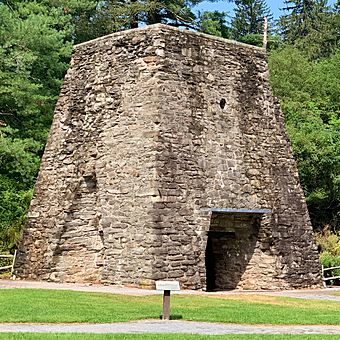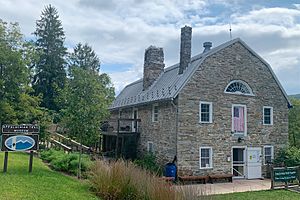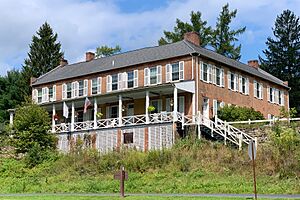Pine Grove Iron Works facts for kids
Quick facts for kids |
|
|
Pine Grove Iron Works
|
|

Furnace in 2019
|
|
| Location | Mountain Creek, Pennsylvania, U.S. |
|---|---|
| Nearest city | Cooke, Pennsylvania, U.S. |
| Area | 188 acres (76 ha) |
| Built | 1764 |
| Architectural style | Italianate |
| NRHP reference No. | 77001158 |
| Added to NRHP | April 13, 1977 |
The Pine Grove Iron Works was a special place in southcentral Pennsylvania during the Industrial Revolution. This was a time when new machines and factories changed how things were made. At Pine Grove, they used a process called smelting to turn iron ore into useful iron products.
Today, you can still see parts of the old iron works. These old buildings and structures are now important historical sites within Pine Grove Furnace State Park. The most famous part is the tall furnace stack of the Pine Grove Furnace. Because of its history and unique buildings, the site was added to the National Register of Historic Places on April 13, 1977. This means it's a special place worth protecting!
Contents
Where is Pine Grove Iron Works?
The Pine Grove Iron Works was built in a small area around its main furnace. It was located near a Mountain Creek. Water from this creek was very important for running the furnace. There was also a quarry nearby where they dug up limestone. Limestone was used to help make the iron.
The Village of Pine Grove
Pine Grove was the village that grew up around the iron works. It was also known as "Pine Grove Furnace." The village had homes for the workers, a church, and a store. By 1886, it even had its own post office. There was also a schoolhouse and a cemetery nearby.
History of the Iron Works
The Pine Grove Furnace was built around 1770. It was one of the first iron furnaces in Cumberland County. Robert Thornburg and John Arthur built it, working with George Stevenson. Stevenson already owned another iron-making place called Laurel Forge.
The furnace's main job was to smelt iron ore. This process made cast iron products. They made things like parts for wagon wheels, fireplace backs, iron kettles, and stoves. Later, in the late 1800s, they even made parts for Baldwin Locomotive trains!
By 1782, the whole area was known as the "Pine Grove Iron-Works." To help the main furnace, other buildings were built nearby. These included water channels (called raceways) and places to make charcoal. Charcoal was the fuel used to heat the furnace.
One important building was the iron master's mansion, built in 1829. This was where the person in charge of the iron works lived. There was also a saw mill built around 1777. The Pine Grove Iron Works used limonite iron ore from a nearby mine and limestone from two quarries.
Connecting by Rail
In 1870, the South Mountain Railroad was built. It had offices right at Pine Grove. This railroad helped connect the furnace to the limestone pits and three active iron ore mines. It made it much easier to get materials to the furnace.

The furnace originally used charcoal for fuel. But in 1874, it stopped working for a short time. By 1877, it was updated to use hotter air (called a hot blast furnace) and could even use other fuels. They started using coke in 1879 and then anthracite coal.
The iron works produced a lot of iron. In its best year, 1883, it made about 6,000 tons of iron! Later, other railroads like the Hunter's Run and Slate Belt Railroad and the Gettysburg and Harrisburg Railway also served the area.
End of an Era
Iron production at Pine Grove ended in 1895. On September 12, 1913, the Pine Grove Iron Works was sold. The land became part of the South Mountain Forest. Later, by 1931, it became a big part of the Pine Grove Furnace State Park.
The Ironmaster's Mansion was fixed up in 1985 and again in 2010-2011. Today, these historical sites help us remember the important role Pine Grove Iron Works played in Pennsylvania's history.
Images for kids



